Electric aircraft, powered by electricity rather than conventional fuels, offer a more environmentally friendly alternative, aligning with the global push towards sustainable travel. As the world grapples with the challenges of climate change, the importance of electric aviation has become more emphatic.
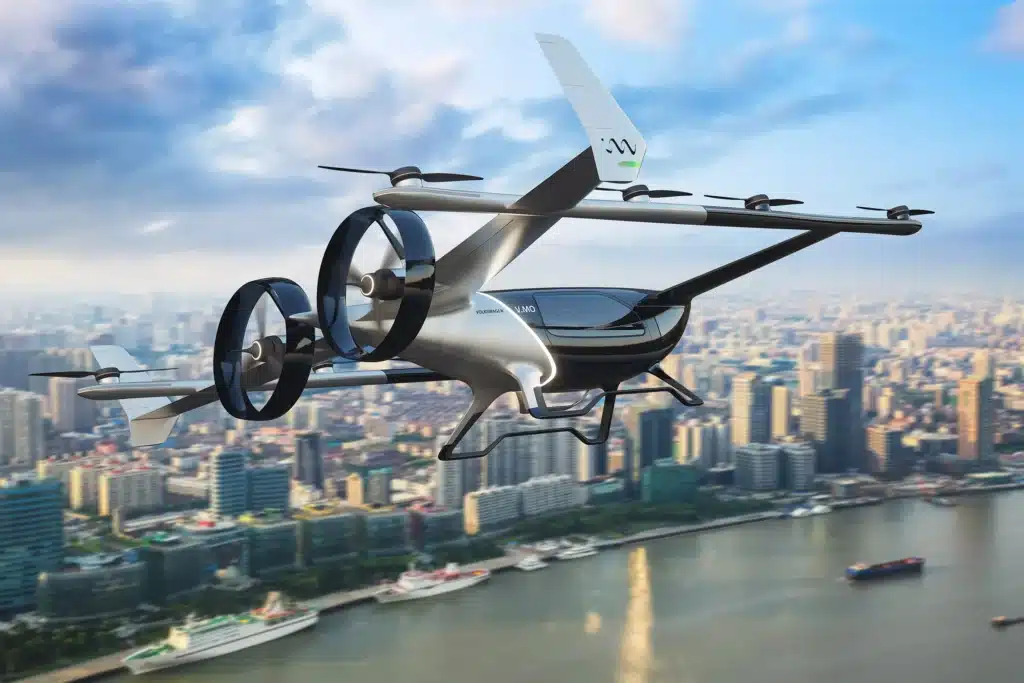
Recently, Hong Kong’s aviation sector highlighted the pressing need for more manpower, indicating a growing demand in the industry. Recent developments, such as the ‘Eenuee’ project, an eco-friendly air taxi initiative, also shows the sector might be another gold-rush.
This surge in interest from investors, driven by the competitive landscape of electric vehicle markets, suggests a race to establish a dominant presence in the electric aviation domain. While still in its infancy, market indicators predict promising returns.
Editor’s Pick: Key Statistics of eVTOL and Electric Aircraft
- Global Market Size of Electric Aircraft in 2023: $9.44 Billion
- Projected Market Size of Electric Aircraft by 2030: $34.90 Billion
- eVTOL Aircraft Market Size in 2023: $12.53 Billion, projected to be $28.34 Billion by 2030
- Sustainable Aviation Fuels Market Size in 2023: $616.9 Million, projected to be $7,320.60 Million by 2030
- Air Mobility Market Size in 2023: $10.93 Billion, projected to be $45.12 Billion by 2030
- Electric Airplane Price Range: $4 Million to $11 Million
- Operational Cost Advantage of Electric vs. Traditional Aircraft: 15-22%
- ROI for Early Investors in Electric Aircraft Market: 200% by 2030
- Fastest All-Electric Plane: Rolls-Royce Spirit of Innovation with a peak speed of 623 km/h
- Leading Electric Aircraft Companies by Revenue: Raytheon Technologies ($64.388 Billion), Boeing ($62.28 Billion), and Airbus SAS ($61.697 Billion)
- Top eVTOL Companies by AAM Reality Index: Joby Aviation (8.7), Velocopter (8.6), and EHang (8.1)
- Predicted eVTOL Demand Surge: Costs dropping from $5.70 per passenger mile in 2025 to $0.44 by 2030
- Potential of Electric Planes in Cargo Transport: Pyka’s autonomous electric cargo plane can transport 400 pounds of cargo 200 miles in less than three hours
- Predicted Environmental Impact Savings: Up to 75% reduction in greenhouse gas emissions
- UK’s Electric Aviation Funding: £113 million in 2023 and an additional £94.25 million in 2023
Market Overview
1. Current 2023 Global Market Size of Electric Aircraft: $9.44 Billion
The global electric aircraft market was valued at $7.91 billion in 2022 and increased to $9.44 billion in 2023¹. This represents a growth of approximately 19.21% between the two years.
The bar chart clearly depicts the growth in the market size from $7.91 billion in 2022 to $9.44 billion in 2023.
2. Projected Market Size of Electric Aircraft by 2030: $34.90 Billion
The Compound Annual Growth Rate (CAGR) for the electric aircraft market from 2023 to 2030 is projected to be 20.6%¹. The market size for the subsequent years is as follows¹:
| Year | Projection |
| 2024 | $11.37b |
| 2025 | $13.70b |
| 2026 | $16.51b |
| 2027 | $19.90b |
| 2028 | $23.99b |
| 2029 | $28.93b |
| 2030 | $34.90b |
Here’s a graphical representation of the table:
The consistent upward trend indicates a positive outlook for the electric aircraft industry, with increasing market demand and potential for expansion in the coming years.
3. Year-on-Year Growth Rate of the Electric Aircraft Market: 19.21% in 2023 to Approx. 20.63% by 2030
After witnessing a growth of approximately 19.21% from 2022 to 2023, the market continued to expand at a steady pace¹. The bar graph showcases the YoY growth rate of the electric aircraft market from 2023 to 2030¹.
Starting from 19.21% in 2023, the growth rate exhibits a slight upward trend, stabilising around the 20.5% mark in the subsequent years. This positive trajectory suggests a promising future.
4. eVTOL Aircraft Current and Projected Market Size: $12.53 Billion (2023), $28.34 Billion (2030)
The market size of eVTOL aircraft was estimated at USD 11.15 billion in 2022 and is currently worth $12.53 billion². This means there’s an increase of approximately 12.38%.
| Year | Market Size |
| 2023 | $12.3b |
| 2024 | $14.08b |
| 2025 | $15.82b |
| 2026 | $17.78b |
| 2027 | $19.98b |
| 2028 | $22.45b |
| 2029 | $25.22b |
| 2030 | $28.34b |
Projected to grow to USD 28.34 billion by 2030, the market is anticipated to nearly triple its size².
This suggests a CAGR of approximately 12.35% over the 8-year period, indicating a robust growth potential for the eVTOL aircraft industry in the coming years.
5. Sustainable Aviation Fuels Market Size and Growth: $616.9 Million (2023), $7,320.60 Million (2030)
In 2022, the global market for Sustainable Aviation Fuels (SAFs) stood at USD 433.26 million, with biofuel and North America dominating the market share³. By 2023, this value is projected to rise to $616.9 million as shown below:
| Year | Market Size |
| 2023 | $616.91m |
| 2024 | $878.41m |
| 2025 | $1,250.76m |
| 2026 | $1,780.93m |
| 2027 | $2,535.84m |
| 2028 | $3,610.75m |
| 2029 | $5,141.29m |
| 2030 | $7,320.60m |
With a Compound Annual Growth Rate (CAGR) of 42.39% from 2023 to 2032, the market is anticipated to reach $7,320.60 million by 2030³.
6. Air Mobility Market Size and Growth: $10.93 Billion (2023), $45.12 Billion (2030)
In 2022, the air mobility market had a valuation of $8.93 billion⁴. The cargo segment dominated that year, contributing 58% to the revenue, while the passenger segment represented 42%. The propulsion type segment contributed 49% of the revenue. By 2023, the market’s value for air mobility has grown to $10.93 billion⁴.
| Year | Market Size |
| 2023 | $10.93b |
| 2024 | $13.38b |
| 2025 | $16.39b |
| 2026 | $20.07b |
| 2027 | $24.57b |
| 2028 | $30.09b |
| 2029 | $36.85b |
| 2030 | $45.12b |
With a CAGR of 22.45%, the air mobility market is projected to soar to $45.12 billion by 2030.
Cost and Economic Viability
7. Electric Airplane Price Range: $4 Million to $11 Million
Electric airplanes’ costs can fluctuate based on factors like size, features, and the manufacturer. Data indicates that prices might start at around $4 million, as seen with models like Eviation’s Alice⁵. Larger hybrid electric aircraft could average around $11 million⁵.
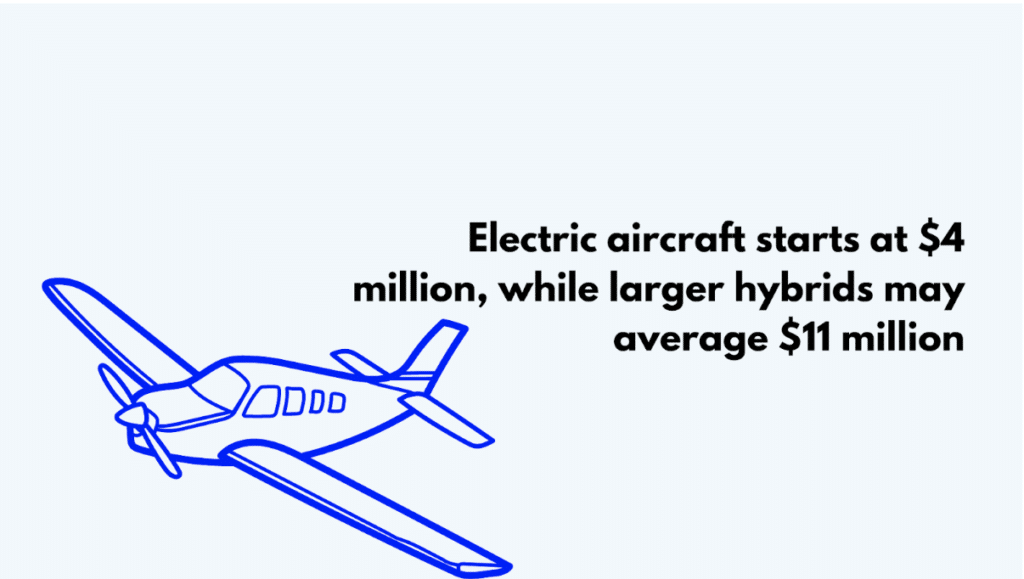
It’s crucial to distinguish that these prices pertain to the acquisition of the airplane, excluding operational expenses. Interestingly, operating an electric aircraft is projected to be much more economical compared to traditional airplanes.
8. Electric vs. Traditional Aircraft Operational Cost Analysis: 15-22% Cost Advantage for Electric
When comparing the total expenses, electric aircraft are more cost-effective, being 15 to 22% less expensive in operational costs than traditional aircraft⁶.
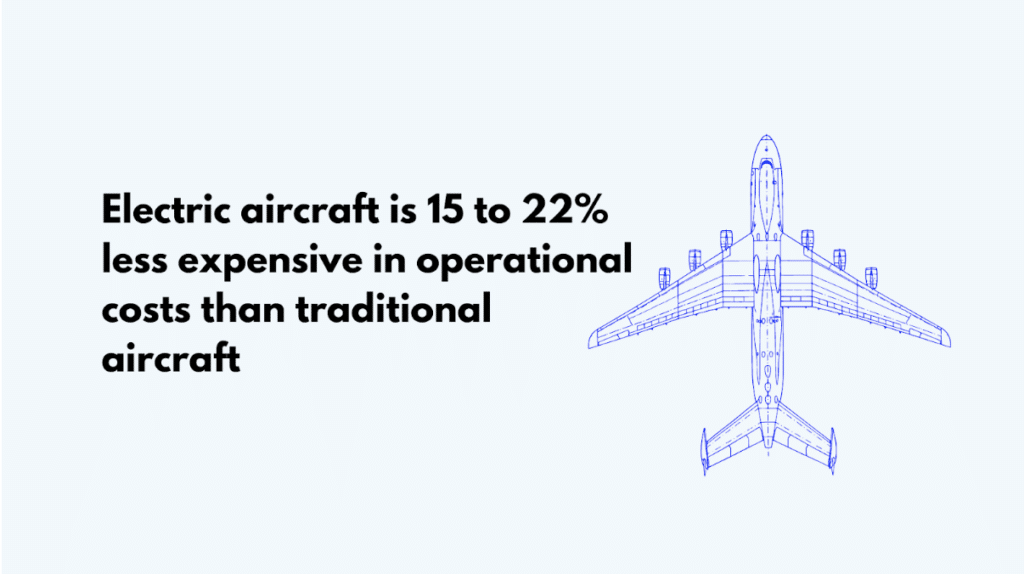
A significant expenditure for electric planes is the ownership cost. Yet, as production scales up, these costs can decrease. Historically, limited production runs have led to higher ownership costs for aircraft.
9. ROI for Early Investors in Electric Aircraft Market: 200% by 2030
Based on projections, the demand for electric aircraft is expected to triple, reaching a market value of $34.90 billion by 2030¹. Given this growth, the Return on Investment (ROI) for early investors is calculated to be 200%.
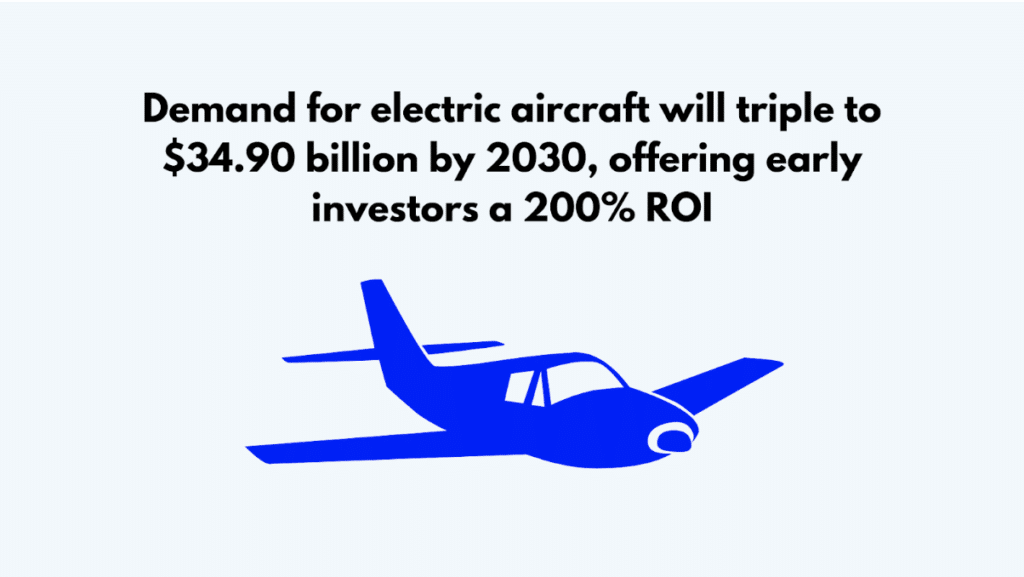
This implies that for every dollar invested at the beginning of the decade, there would be a return of three dollars by 2030, effectively doubling the initial investment.
10. eVTOL Cost and ROI: $2.25 and $11 Per Mile
Joby Aviation has received the most investment with a market capitalisation of over $4.9 billion and an average stock price target set at $7.67⁷. Passenger costs estimates indicate that eVTOL services might charge between $2.25 and $11 per mile⁷.
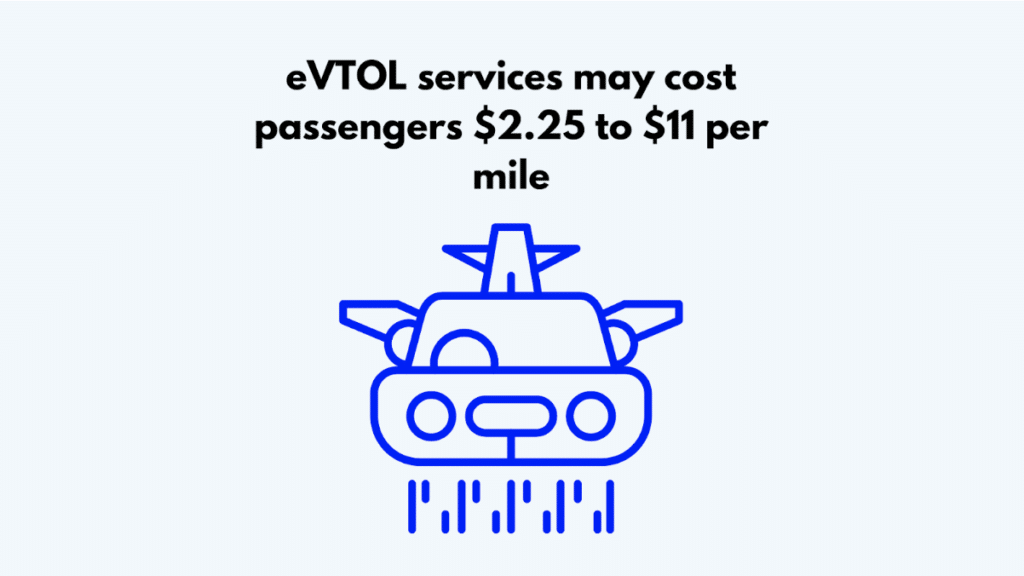
For perspective, Blade Urban Air Mobility, currently operating helicopters, prices its service at $195 per seat for a journey spanning approximately 14 miles between Manhattan and JFK Airport. Drawing from this, Robin Riedel of McKinsey & Company approximates the expense for an eVTOL passenger undertaking a 25-mile flight to hover around $110.
Sources: Precedence Research¹, Precedence Research², Precedence Research³, Precedence Research⁴, Clean Technica⁵, Kawthar Shahwan⁶, and Flying Mag⁷.
Speed, Performance, and Innovation
11. Debut of the First All-Electric Plane: 1973
In 1973, the MB-E1 marked a significant milestone by becoming the first all-electric plane to achieve a crewed free flight in Germany¹. Designed by Heino Brditschka and produced by MB Flugtechnik, this pioneering aircraft utilised nickel-cadmium batteries. It boasted a range of 5 km and could reach top speeds of 120 km/h (75 mph).

14. First All-Electric Commercial Aircraft Launch: December 2019
December 2019 was the launch of the first all-electric commercial plane, the Harbour Air ePlane, in Vancouver, Canada². This brief three-minute flight symbolised the beginning of an ambitious project to establish the world’s premier all-electric commercial fleet. This initiative was a collaborative effort between Harbour Air and magniX.
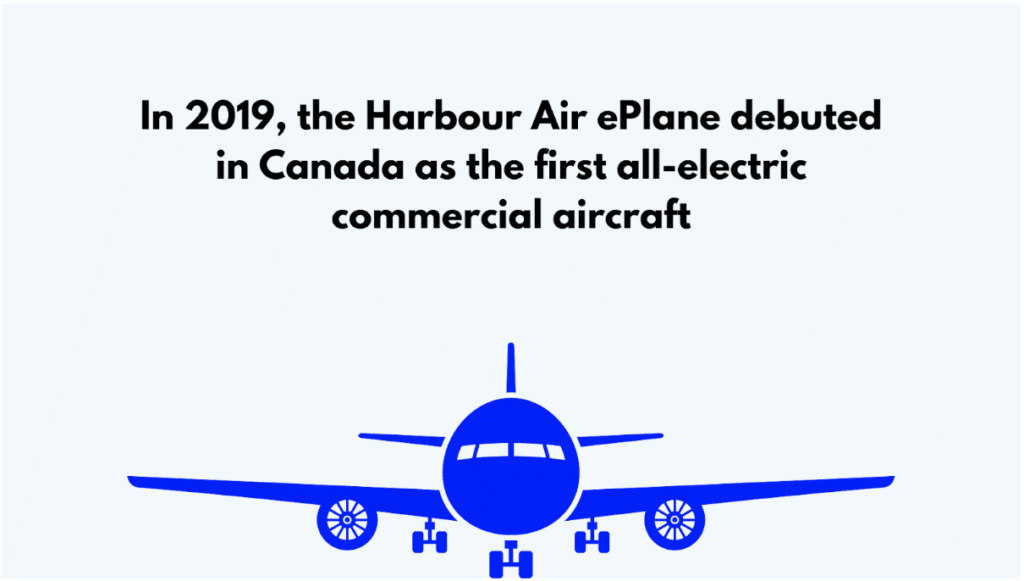
15. Fastest All-Electric Plane: Rolls-Royce Spirit of Innovation
Earning the title of the fastest all-electric plane, the Rolls-Royce Spirit of Innovation shattered three world speed records in November 2021³. It achieved a peak speed of 623 km/h (387.4 mph) over a 3 km distance and maintained average speeds of 555.9 km/h (345.4 mph) over 3 km and 532.1 km/h (330 mph) over 15 km. Additionally, it ascended to 3,000 m in a mere 202 seconds, surpassing the previous record by a full minute.
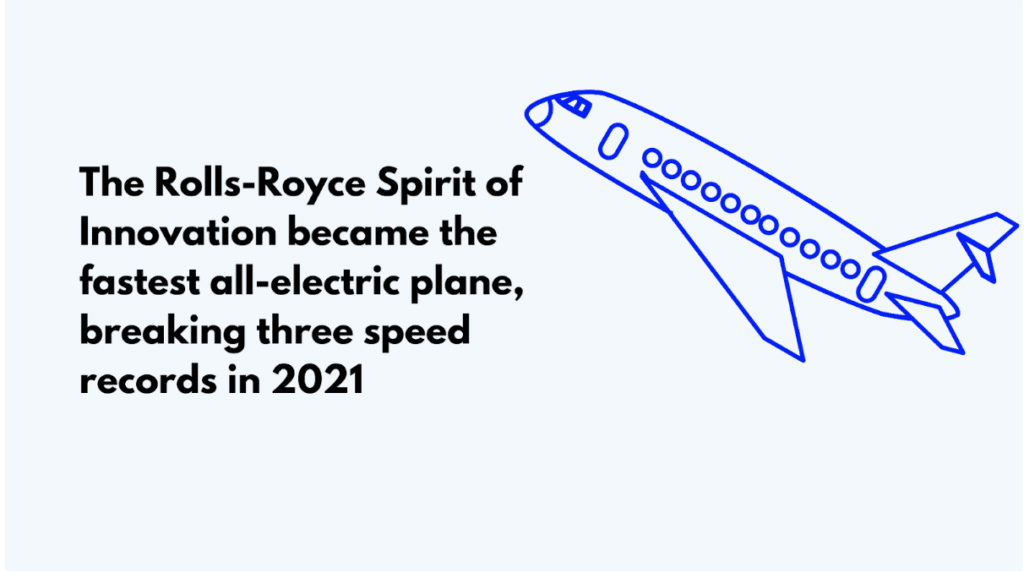
16. Speed and Range of eVTOL Air Taxis and Flying Cars:
The CityAirbus NextGen cruises at 120 km/h with a range of 80 km⁴. Meanwhile, the Wisk Generation 6 travels at 140 mph and covers 90 miles⁵. Plus, it features an autonomous flight mode, allowing it to operate without a pilot.
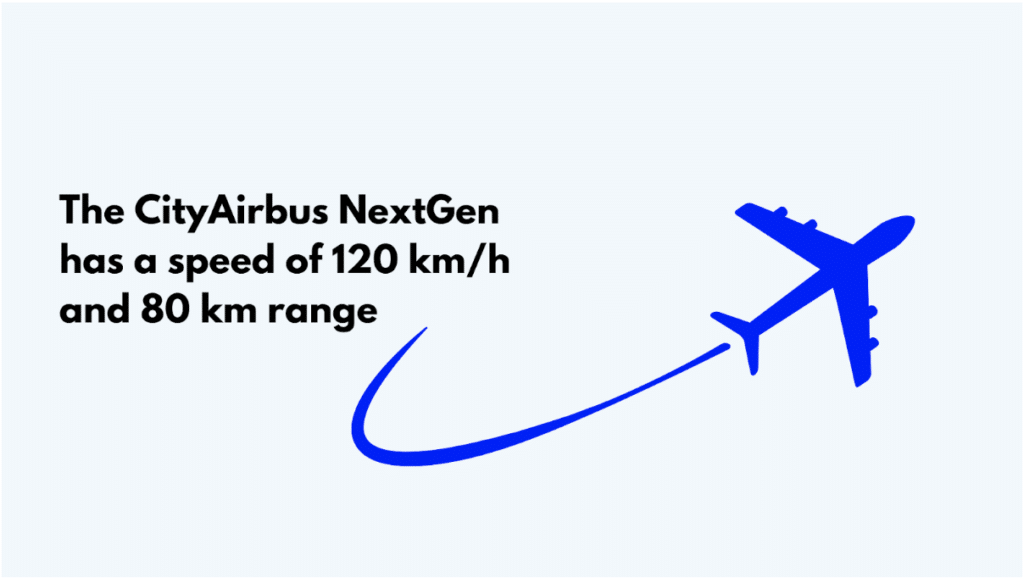
Major Players and Market Dynamics
19. Leading Electric Aircraft Companies by Revenue
Raytheon Technologies Corporation leads the chart of the top ten electric aircraft companies in the world with a revenue of US$64.388 billion, closely followed by Boeing and Airbus SAS⁶. Here’s a look at the table:
| Companies | Revenues |
| Raytheon Technologies | $64.388 Billion |
| Boeing | $62.28 Billion |
| Airbus SAS | $61.697 Billion |
| Honeywell International Inc | $34.392 Billion |
| BAE Systems | £19.52 Billion |
| Thales | $17.1 Billion |
| Safran SA | $ 13.9 Billion |
| Ametek Inc. | $5.547 Billion |
| Yuneec Holding Limited | $545.3 Million |
| Joby Aviation | $333.5 Million |
Plotting a visual representation to reveal the lowest company by revenue to the highest:
It’s important to note that these revenue figures encompass the entire business operations of the companies, not just their electric aircraft divisions.
20. Top 10 eVTOL Companies: AAM Reality Index Rankings
Joby Aviation takes the top spot with an AAM Reality Index score of 8.7, closely followed by Velocopter at 8.6. EHang, Beta Technologies, and Archer share the same score of 8.1⁷. Below is the full ranking:
| eVTOL Companies | AAM Scores |
| Joby Aviation | 8.7 |
| Velocopter | 8.6 |
| EHang | 8.1 |
| Beta Technologies | 8.1 |
| Archer | 8.1 |
| Wisk(Boeing) | 7.5 |
| Elroy Air | 7.4 |
| Eve Holding | 7.2 |
| Autoflight | 7.2 |
| Pipistrel(Textron) | 7.2 |
Based on the provided scores, here’s a visual representation of the top ten eVTOL companies:
21. Leading Flying Car Startups and Companies
Some of the standout names in the flying car sector include SkyDrive Inc., Joby-Aviation, Lilium, Archer Aviation, Aeromobil, and Alef Aeronautics.
22. Number of Patents Filed by Leading Electric Aircraft Companies
The top five electric aircraft patent holders in the automotive sector in North America between 2002 and 2022 are SZ DJI Technology Co Ltd (130 patents), General Electric Co (120 patents), Rolls-Royce Holdings Plc (109 patents), The Boeing Co (108 patents) and Airbus SE (90 patents)⁸.
23. Most Innovative Electric Aircraft Designs
Some of the most innovative electric aircraft designs include Foster + Partners’ vertiport terminal for Dubai, ZeroAvia’s hydrogen-electric plane that can fly 76 passengers over 500 miles, Volkswagen’s Flying Tiger eVTOL car that can also drive on the road, and Airbus’ Bird of Prey concept that mimics natural features of birds⁹.

Sources: BBC¹, BBC², Lambert Mark³, AirBus⁴, Robb Report⁵, Emergen Research⁶, Aviation Week⁷, Globaldata⁸, and Dezeen⁹
Investing in Electric Aviation and eVTOL
25. Best Performing Electric Aviation Stocks Include Joby Aviation
Some of the best performing electric aircraft stocks include¹:
- Archer Aviation: Successfully tested its Maker’s hover capabilities, aiming for an air taxi service debut by 2024.
- Joby Aviation: A decade of vehicle testing under its belt and acquired Uber’s flying car division in 2020.
- Vertical Aerospace: Boasts over 1,000 vehicle pre-orders from giants like American Airlines and Virgin Atlantic, and collaborates with Rolls-Royce.
26. Best eVTOL and Electric Aircraft ETFs Include UAV ETFs
There are several ETFs that hold one or more stocks tagged as electric aircraft, such as:
- UAV (AdvisorShares Drone Technology ETF): Focuses on drone tech, including eVTOLs. Holds 13.96% in electric aviation stocks with a 2.96% YTD return².
- EVAV (Direxion Daily Electric & Autonomous Vehicles Bull 2X Shares): Targets companies in electric and autonomous vehicle sectors. Contains 3.93% electric aviation stocks, achieving a 6.43% YTD return².
- ARKX (ARK Space Exploration & Innovation ETF): Invests in space tech-related firms. Allocated 3.21% to electric aviation stocks, with a YTD return of -2.21%².
27. Investment Risks in Electric Aviation
Investing in electric aviation comes with its set of challenges³:
- Technological Hurdles: Electric planes grapple with issues like battery weight, energy density, and ensuring consistent safety and reliability.
- Regulatory Ambiguity: The industry navigates a maze of regulations, from emissions and noise standards to safety certifications.
- Competitive Landscape: Beyond traditional aviation, electric flight contends with alternative transport like high-speed trains and road vehicles.
- Investment Fluctuations: Being capital-heavy, the sector demands prolonged investments, making financing a critical concern.
Future Predictions and Trends
28. Predicted Trends for the Next Decade in Electric Aviation
The next decade will witness a surge in eVTOL demand, driven by their promise of swift, eco-friendly urban commutes. These aerial vehicles will harness advanced tech like AI, machine learning, and blockchain, bolstering their safety and autonomy.
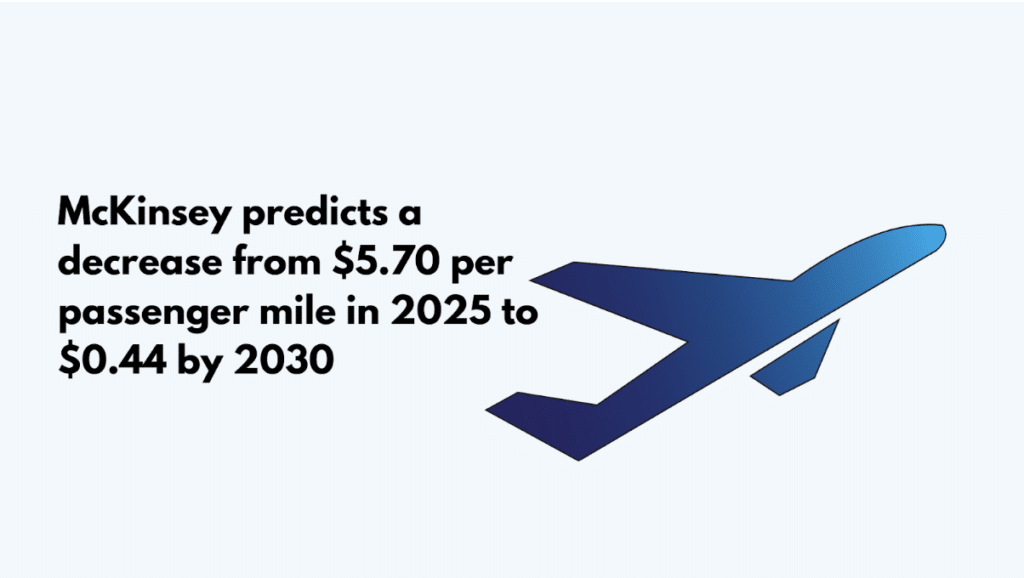
As they become mainstream, costs are predicted to plummet; McKinsey estimates a drop from $5.70 per passenger mile in 2025 to just $0.44 by 2030⁴. The industry is also championing diversity; for instance, Joby Aviation’s pilot training initiative focuses on enrolling more women and individuals from diverse backgrounds.
29. Potential for Electric Planes in Cargo Transport
Electric cargo planes are a popular concept, and California-based startup Pyka has unveiled an autonomous electric cargo plane capable of transporting 400 pounds of cargo 200 miles in less than three hours⁵. DHL has also ordered 12 electric cargo planes, each capable of carrying up to 2,600 pounds⁶.
30. Predicted Environmental Impact Savings Could Reach 75%
Electric aviation could reduce greenhouse gas emissions by up to 75% compared to conventional aircraft, while eVTOL could offer a more efficient and sustainable alternative to ground transportation in urban areas⁴.
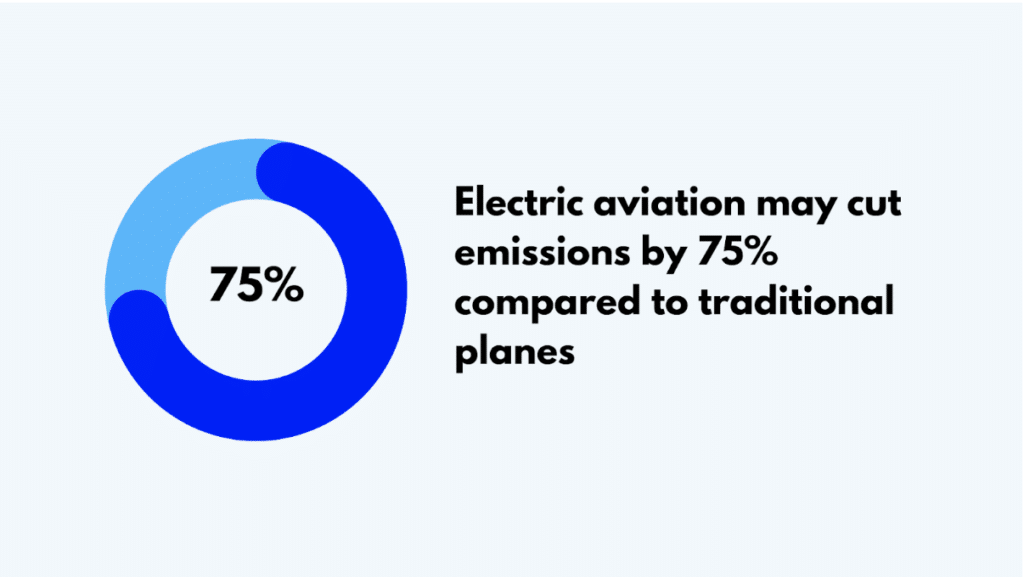
Source: Markets Insider¹, Swing Trade Bot², Onrel³, McKinsey⁴, Flypyka⁵, and DHL⁶.
Electric Aviation in the UK
31. UK’s Electric Aviation Landscape
In February 20231, the government announced a £113 million fund dedicated to the research and development of zero-emission electric aircraft. Fast forward to March 20232, the government added £94.25 million to foster the creation of technologies with the potential to introduce electric flying taxis and establish a carbon-neutral aviation sector.
By 2050, it’s understood that the government’s ambitious ‘Jet Zero’ has a plan to achieve net-zero aviation emissions.
32. UK’s Share in the Global Electric Aircraft Market
In 20194, the United Kingdom’s aerospace industry commanded a 17% share of the global market. By 20235, the UK aviation market’s value is estimated to reach USD 15.20 billion.
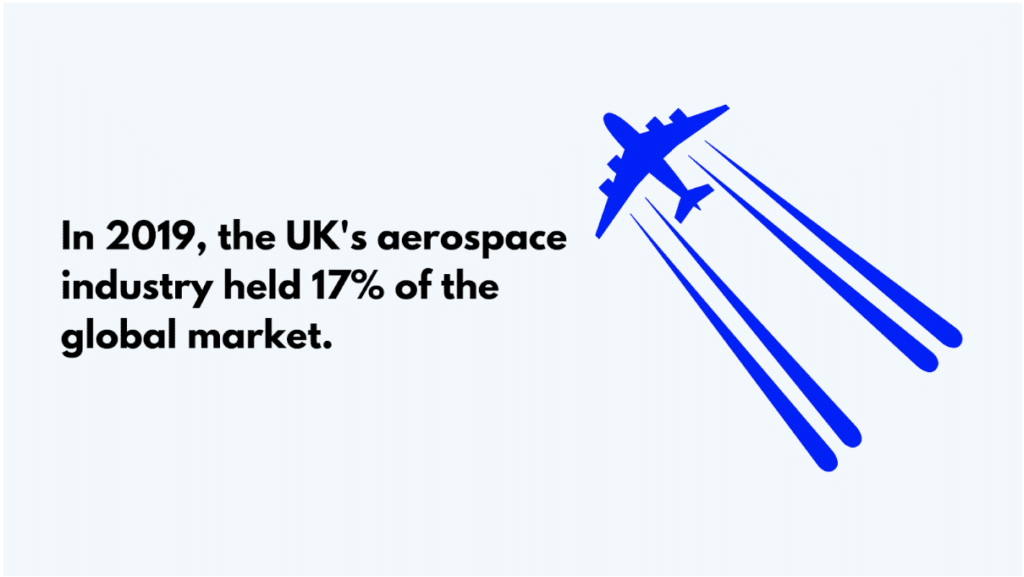
33. UK-Based Electric Aircraft Companies
Leading projects and participants who led the electric aviation invention in the UK include the following3:
- 2Zero (Towards Zero Emission In Regional Aircraft Operations): Logan Air, Rolls-Royce Electrical, Nottingham University, Exeter and Devon Airports, Cornwall Airport, Heart of the Southwest Local Enterprise Partnership (HotSWLEP), UK Power Network Services and lead by Ampaire, led this project.
- HyFlyer I & II: ZeroAvia, in collaboration between EMEC, Aeristech, BEIS, ATI and Innovate led this project.
- InCEPTion: Bluebear Systems, Dowty Propellers, Drive System Design, Ricardo, M&I Materials, University of Cambridge’s Whittle Laboratory, University of Salford’s Acoustics Research Centre, ATI, delivered this project.
- BEHA: Fardair, the lead player, and the collaborations between MagniX, Honeywell, Cambridge Consultants, Nova Systems, Swansea University delivered this project.
- H2Gear: GKN Aerospace in collaboration with Intelligent Energy, Aeristech, Newcastle University, The University of Manchester and University of Birmingham will deliver this project.
- Project Fresson: The Fresson consortium, which includes Britten Norman, Delta Motor Sport, Dennis Ferranti, Warwick Manufacturing Group and Cranfield Aerospace Solutions (CAeS) are working to deliver this project.
Interestingly, there are many top aircraft companies based in the United Kingdom. Here are the top aircraft companies, including their annual revenues from 2020 through 2022.
| UK Aircraft Comp. | 2020 (£) | 2021 (£) | 2022 (£) |
| Airbus UK6 | 44.9 billion | 48.48 billion | 48.65 billion |
| BAE Systems7 | 19.45 billion | 21.09 billion | 20.65 billion |
| Rolls Royce8 | 11.92 billion | 12.12 billion | 13.13 billion |
| Cobham | Not Specified | 2.45 billion | 1.89 billion |
| Meggitt PLC | 1.80 billion9 | 1.65 billion9 | 1.65 billion* |
| QinetiQ** | 1.04 billion | 1.37 billion | 1.36 billion |
| Ultra Electronics | 859.8 million | 850.7 million | 982.9 million |
Sources: Innovation News Network1, Environmental Leader2, Foresight Events3, Wikipedia4, Mordor Intelligence5, Macrotrends6, Macrotrends7, Macrotrends8, Companies Market Cap9, Zippia*, and Companies Market Cap**.
Conclusion
The electric aircraft and eVTOL market is experiencing significant growth, with the global electric aircraft market valued at $9.44 billion in 2023 and projected to reach $34.90 billion by 2030. The eVTOL market, currently worth $12.53 billion, is expected to nearly triple its size by 2030. Electric aircraft offer cost advantages in operational expenses compared to traditional aircraft, with electric planes being 15-22% cheaper to operate.
FAQs
Electric Aircraft: $9.44 billion in 2023. eVTOL: $12.53 billion in 2023.
Electric aircraft market projected to reach $34.90 billion by 2030. eVTOL market projected to reach $28.34 billion by 2030. Surge in eVTOL demand expected in the next decade, with costs predicted to drop significantly.
Electric aircraft are 15-22% less expensive in operational costs than traditional aircraft. The fastest all-electric plane, Rolls-Royce Spirit of Innovation, reached a peak speed of 623 km/h.
The MB-E1, the first all-electric plane, had a range of 5 km. CityAirbus NextGen has a range of 80 km. Wisk Generation 6 covers 90 miles.
Leading Electric Aircraft Companies by Revenue: Raytheon Technologies, Boeing, and Airbus SAS. Top eVTOL Companies: Joby Aviation, Velocopter, EHang, Beta Technologies, and Archer. Rolls-Royce Spirit of Innovation set three world speed records in November 2021.
